Apr 24, 2025
Apr 24, 2025
Director: Kon Ichikawa/ Japan/Japanese/113 mts
An Actor's Revenge, directed by the renowned Kon Ichikawa (famous for 'Burmese Harp'), is an absolutely gorgeous film. It is both visually stunning and profoundly affecting. The director has fashioned such lovely and elegant movie that the viewer cannot help but be so enthralled by the experience of watching it that he is made to feel all the anger and sadness of its characters with a terrible poignancy.
Every scene of the movie is skillfully filmed, perfectly staged, and suffused with a diverse array of vibrant colors. Beginning with a sumptuous presentation of a moment from a Kabuki play being performed by Yukinojo's troupe, that is so enchantingly realized that the viewer is likely to be astonished by the sensitivity with which it has been brought to the screen, Ichikawa proceeds to unveil a dreamlike world charged with an almost painful beauty.
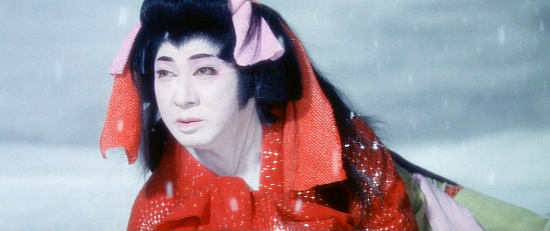
Yukinojo during Kabuki performance notices murderers of his parents
This loveliness is made all the more affecting by the film's artificiality. Rather than moving from the rarefied landscape of the stylized play which is presented in its first scene to that of ordinary experience, An Actor's Revenge maintains a feeling of unreality throughout. Ichikawa never tries to trick the viewer into believing that he is looking at some place in the real world by mimicking the objects of ordinary experience, but rather allows the moviegoer to relish the innate beauty of each of the film's elegant sets. The viewer is, consequently, always reminded that he is watching a movie and not looking through a window at the doings of ordinary persons. Being so able to engage directly with the film, he is transported to and immersed in a world of uncanny loveliness.
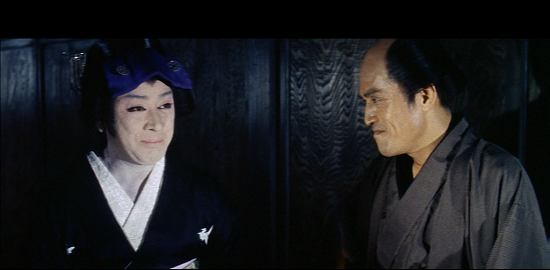
Yukinojo encounters the merchant Kawaguchiya
A man playing a woman who seduces a beautiful young woman to help pull off a plan to achieve revenge against three moguls who were responsible for his parents' death? Sounds like a real loser, but instead it is a sensitive beautifully acted and amazingly staged movie.
“An Actor’s Revenge” is a wildly melodramatic tale of a kabuki female impersonator who exacts a long-delayed revenge on the men who drove his parents to suicide is played out against a backdrop of comic rivalries between thieves in the Tokyo underworld. Kazuo Hasegawa plays the dual role of the actor and the thief in a film which celebrates his 300th screen appearance. A heady mixture of swooning romanticism and stylized action, with a soundtrack that ranges from traditional Japanese music to lush Hollywood strings and cocktail jazz, An Actor’s Revenge is a cinematic tour de force.
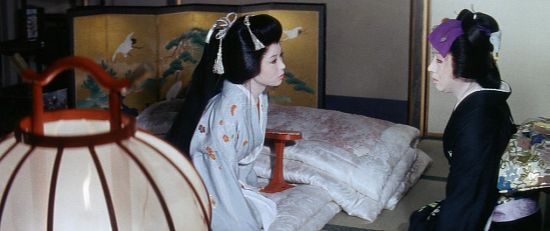
Yukinojo meets Namiji, Sansai Dobe's daugher
In this renowned Japanese film, the great Kabuki onnagata Kasuo Hasegawa celebrates his 300th film appearance in a role designed especially for him. One of the classic theater styles of Japan, Kabuki does not use women in female roles. Highly trained male actors, called "onnagata," perform in them, and are often more convincing as women than many women might be. In the story, set in 1836, Yukinojo (Kasuo Hasegawa) is an onnagata, travelling to Edo in feminine disguise. On his journey, he recognizes three ruthless merchants who ruined his father's business, driving him to suicide. Pledged to revenge his father's death, he follows them, and with the help of a mysterious bandit martial artist named Yamitaro (also Hasegawa), fulfills his pledge, even though this means the destruction of one of the merchant's innocent daughters, who has fallen in love with him. Actor Hasegawa performed these same roles in a 1935 film version of this same story, directed by Teinosuke Kinugasa, who consulted on this film.
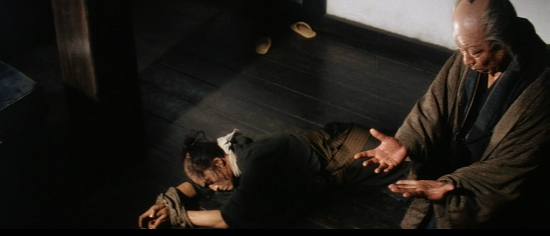
A scene where the merchant Kawaguchiya is killed by his competitor Hiromiya
The actor playing the Kabuki actor, K.Hasegawa, also plays a local tough guy who helps the actor. Had An Actor’s Revenge been a mediocre work - which it most assuredly is not - then it would still possess a certain cultural curiosity. The film was, after all, the “300th film of Kazuo Hasegawa” (as the opening title proudly proclaims) and saw the former matinee idol revisit a title role he has essayed 27 years earlier in Yukinojo the Phantom. The fact that he was now 55, considerably weightier and sporting a double chin seemingly posed no problem.
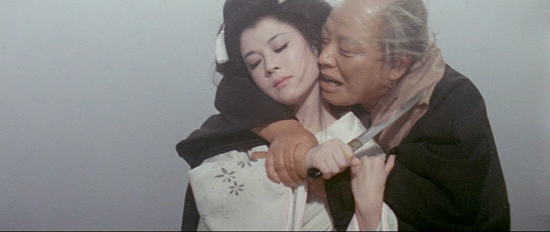
Hiromiya trying to abduct Namiji
From the onset, Ichikawa’s irreverent and sardonic humor would define the infectiously playful, yet stylistically audacious and self-assured tone of the film’s eccentric fusion of high-brow art and pop culture kitsch. Bearing the imprint of his early training as an animation illustrator and artist (Ichikawa often cites Walt Disney as his most formative influence), Yukinojo’s interior monologue, which occurs during the staid, dramatic theatricality of a kabuki performance, is shown through an incongruous peripheral view that is patterned after a comic strip thought bubble as he catches sight of his father’s conspirators (and also notes the absence of Hiromiya [Eijaro Yanagi], his late father’s ruthless competitor): a politically connected, corrupt retired magistrate named Sansai Dobe (Ganjiro Nakamura) and his wealthy merchant ally, Kawaguchiya (Saburo Date). Yukinojo also finds the unwitting instrument of his revenge in Dobe’s hopelessly romantic daughter, Namiji (Ayako Wakao), the mistress of a powerful shogun, who is shown visibly swooning in the film’s opening sequence (and in the process, runs through an amusing gamut of hackneyed gestural acting conventions) over his sympathetic and moving performance.
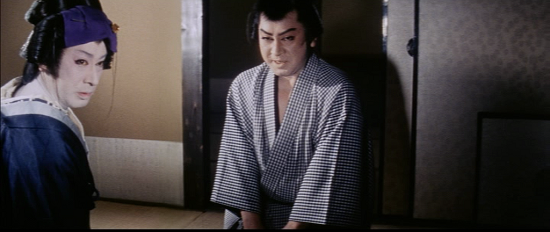
Double encounter: The actor and the thief
The intoxicating sense of otherworldliness in this film is heightened by the director's having Kazuo Hasegawa appear not only as Yukinojo but also as a thief named Yamitaro, with whom the former frequently interacts. Not content so to divide one man between two roles and, thereby, blur his individuality, Ichikawa also blurs the line dividing his actors from his audience. To do so, the director often places Yamitaro on a rooftop or atop a wall overlooking the other actors so that, while he remains a participant in the story, he is also able to watch them as though he were an outside observer. Ichikawa even allows the moviegoer to participate in his characters' inner lives by having the actors speak the thoughts of the persons they are playing.
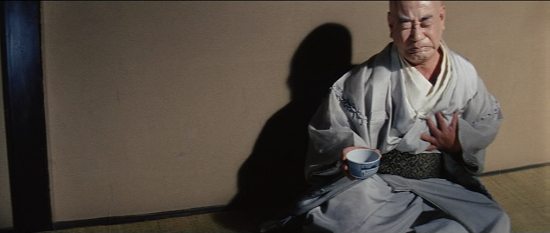
The last enemy: Retired magistrate Sansai Dobe meets his destiny
This is a key film of the modern cinema that features breathtaking cinematography, editing and sound. Kon Ichikawa is a neglected master filmmaker whose entire eclectic body of work deserves far more attention than it has received - especially in the United States. He uses the widescreen to full effect in adopting the aesthetics of the Kabuki theater. The sheer visual inventiveness of the movie makes for the best kind of eye candy. There are bold splashes of primary colors and dramatic, very theatrical lighting. Some sets are intentionally artificial-looking while others are not. Somehow the two styles don't clash but instead portray the perfect intermingling of theater and cinema. Similarly, the use of jazz and lounge music(!) seems perfectly appropriate.
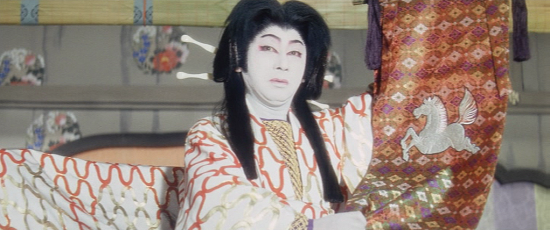
The parting flourish of the Kabuki actor
For those with a taste for the kabuki aesthetic, it should certainly provide a heady brew, possessing all the requisite orientalist elements to have had most westerners wide-eyed in wonder at the time of its first screenings abroad - a uniquely Japanese "traditional" theme and setting, and an eclectic and inventive visual style marked out by vibrant colors and masterly pictorial composition.
Ichikawa supposedly made this movie "to see what cinema could do." He pulls out all the stops and the result is a masterpiece of visual splendor, wit and style that is stunning as well as very entertaining.
A series of Hundred Favorite Films Forever"
18-Dec-2012
More by : P. G. R. Nair